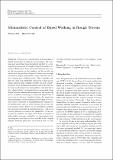| dc.contributor.author | Iida, Fumiya | |
| dc.contributor.author | Tedrake, Russell Louis | |
| dc.date.accessioned | 2012-08-06T20:48:34Z | |
| dc.date.available | 2012-08-06T20:48:34Z | |
| dc.date.issued | 2010-01 | |
| dc.date.submitted | 2009-04 | |
| dc.identifier.issn | 0929-5593 | |
| dc.identifier.issn | 1573-7527 | |
| dc.identifier.uri | http://hdl.handle.net/1721.1/72000 | |
| dc.description.abstract | Toward our comprehensive understanding of legged locomotion in animals and machines, the compass gait model has been intensively studied for a systematic investigation of complex biped locomotion dynamics. While most of the previous studies focused only on the locomotion on flat surfaces, in this article, we tackle with the problem of bipedal locomotion in rough terrains by using a minimalistic control architecture for the compass gait walking model. This controller utilizes an open-loop sinusoidal oscillation of hip motor, which induces basic walking stability without sensory feedback. A set of simulation analyses show that the underlying mechanism lies in the “phase locking” mechanism that compensates phase delays between mechanical dynamics and the open-loop motor oscillation resulting in a relatively large basin of attraction in dynamic bipedal walking. By exploiting this mechanism, we also explain how the basin of attraction can be controlled by manipulating the parameters of oscillator not only on a flat terrain but also in various inclined slopes. Based on the simulation analysis, the proposed controller is implemented in a real-world robotic platform to confirm the plausibility of the approach. In addition, by using these basic principles of self-stability and gait variability, we demonstrate how the proposed controller can be extended with a simple sensory feedback such that the robot is able to control gait patterns autonomously for traversing a rough terrain. | en_US |
| dc.description.sponsorship | National Science Foundation (U.S.) (grant 0746194) | en_US |
| dc.description.sponsorship | Swiss National Science Foundation (grant PBZH2-114461) | en_US |
| dc.description.sponsorship | Swiss National Science Foundation (grant PP00P2_123387/1) | en_US |
| dc.language.iso | en_US | |
| dc.publisher | Springer Netherlands | en_US |
| dc.relation.isversionof | http://dx.doi.org/10.1007/s10514-009-9174-3 | en_US |
| dc.rights | Creative Commons Attribution-Noncommercial-Share Alike 3.0 | en_US |
| dc.rights.uri | http://creativecommons.org/licenses/by-nc-sa/3.0/ | en_US |
| dc.source | Tedrake via Amy Stout | en_US |
| dc.title | Minimalistic control of biped walking in rough terrain | en_US |
| dc.type | Article | en_US |
| dc.identifier.citation | Iida, Fumiya, and Russ Tedrake. “Minimalistic control of biped walking in rough terrain.” Autonomous Robots 28.3 (2010): 355-368. | en_US |
| dc.contributor.department | Massachusetts Institute of Technology. Computer Science and Artificial Intelligence Laboratory | en_US |
| dc.contributor.department | Massachusetts Institute of Technology. Department of Electrical Engineering and Computer Science | en_US |
| dc.contributor.approver | Tedrake, Russell Louis | |
| dc.contributor.mitauthor | Tedrake, Russell Louis | |
| dc.relation.journal | Autonomous Robots | en_US |
| dc.eprint.version | Author's final manuscript | en_US |
| dc.type.uri | http://purl.org/eprint/type/BookItem | en_US |
| eprint.status | http://purl.org/eprint/status/PeerReviewed | en_US |
| dspace.orderedauthors | Iida, Fumiya; Tedrake, Russ | en |
| dc.identifier.orcid | https://orcid.org/0000-0002-8712-7092 | |
| mit.license | OPEN_ACCESS_POLICY | en_US |
| mit.metadata.status | Complete | |
